Foreign Edition Challenges
When making a book, the ultimate goal is for people to buy it. Whether the customer is your close friend or family member, or a stranger in a book shop, you’ve achieved something special either way.
Once it’s out in the world, your book may then catch the eye of foreign publishers, who would also like to share your work with their audiences. Fantastic opportunities like this can help authors’ and illustrators’ careers, allowing readers across the globe to access their work. And in my case, learn about some incredible creatures!
I have been lucky enough to have had my book published in over 7 countries, including the UK, US, South Korea, Sweden, Israel, Russia, Japan and more. Most of the time the foreign publishing process is very straight forward, especially if you are going through a publishing house that does the hard work for you. In my situations, I was generally only required when contracts needed signing and if revisions needed making. Outside of that, I sat back and waited for the finished copies to arrive in the mail.
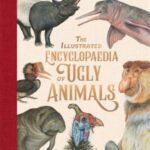 Some books stay the same throughout this process. Others may undergo a full transformation, such as translating the texts into different languages, having their appearances changed, or even altering the titles. A great example of this is when one of my books was published in the US. The publishers decided that the title should be changed from, The Illustrated Encyclopaedia of Ugly Animals, to A Curious Collection of Peculiar Creatures, and that a layout and
Some books stay the same throughout this process. Others may undergo a full transformation, such as translating the texts into different languages, having their appearances changed, or even altering the titles. A great example of this is when one of my books was published in the US. The publishers decided that the title should be changed from, The Illustrated Encyclopaedia of Ugly Animals, to A Curious Collection of Peculiar Creatures, and that a layout and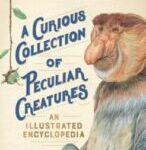 some animals needed replacing. These decisions were made because they believed their audience would react better to the removal of the term ‘ugly’ from the title, whereas the style change was done to better fit their existing book inventory. While this was more of an extreme transformation, I was consulted on every modification and felt very satisfied with the final product.
some animals needed replacing. These decisions were made because they believed their audience would react better to the removal of the term ‘ugly’ from the title, whereas the style change was done to better fit their existing book inventory. While this was more of an extreme transformation, I was consulted on every modification and felt very satisfied with the final product.
When publishing The Illustrated Encyclopaedia of Peculiar Pairs in Nature (which changed to A Curious Collection of Wild Companions), they wanted to see more American based animal pairs for their audience. So I went ahead and included the American badger with the coyote, 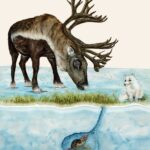 the cactus plant with the yucca moth, the caribou with the Arctic fox,
the cactus plant with the yucca moth, the caribou with the Arctic fox, 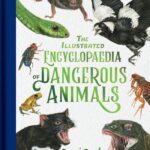 and the eastern chipmunk with the oak tree. I also redrew the wolverine for the US edition of The Illustrated Encyclopaedia of Dangerous Animals. This was requested by the US publishers as they thought the change of position would be perfect for the cover.
and the eastern chipmunk with the oak tree. I also redrew the wolverine for the US edition of The Illustrated Encyclopaedia of Dangerous Animals. This was requested by the US publishers as they thought the change of position would be perfect for the cover.
However, you can sometimes run into complications when publishing foreign editions. They can even become quite the ethical dilemma. When The Illustrated Encyclopaedia of Ugly Animals was being prepared for print in the UK, we had to put a halt on things because of a disagreement. The dispute was not with the UK publishers, but rather the foreign printers.
It’s not uncommon for publishers to print outside of their country, but where the issue arose was with a particular animals’ conservation status that shared the country of the printers (China). The printing spokesperson stated that the animal was not critically endangered and that it actually faced no threats, and in order to continue I would have to change its status in the book.
While I did not (and still do not) agree with the animal not being critically endangered, I felt torn at losing such a huge opportunity of having my book published in another country.
My compromise was not to include the conservation status on the animal’s page at all, which fortunately, the printers were happy with, and we were able to go ahead with the making of the book.
I didn’t feel as though I was compromising my ethics, as I felt that I was making a vital decision that would allow for my book to reach thousands of nature loving children, who if curious, could look up the animals’ status and uncover the truth for themselves.
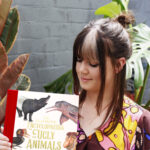 Sami Bayly is an author and illustrator currently based in Newcastle, NSW. She loves all things weird and wonderful and enjoys painting realistic flora and fauna. After studying a bachelor of Natural History Illustration, she has published five books, three of which are part of The Illustrated Encyclopaedia series: The Illustrated Encyclopaedia of Ugly Animals, The Illustrated Encyclopaedia of Dangerous Animals and The Illustrated Encyclopaedia of Peculiar Pairs in Nature.
Sami Bayly is an author and illustrator currently based in Newcastle, NSW. She loves all things weird and wonderful and enjoys painting realistic flora and fauna. After studying a bachelor of Natural History Illustration, she has published five books, three of which are part of The Illustrated Encyclopaedia series: The Illustrated Encyclopaedia of Ugly Animals, The Illustrated Encyclopaedia of Dangerous Animals and The Illustrated Encyclopaedia of Peculiar Pairs in Nature.
Her latest two books, however, are in a newly released series about animal evolution stories. They are, How We Came To Be – Surprising Sea Creatures and How We Came To Be – Creatures of Camouflage and Mimicry, all published by Lothian/Hachette Australia.
She can’t wait to see what her future holds!
*Image taken from Primary English Teaching Association :PETAA blog
See also:
NCACL Catalogue
Bayly, Sami | books
Sami Bayly’s Research file number is number 547 created by NCACL volunteers in October 2022.
Posted by: NCACL | Published: 31 Aug 2024

0 Comments
There are currently no comments, be the first to leave one